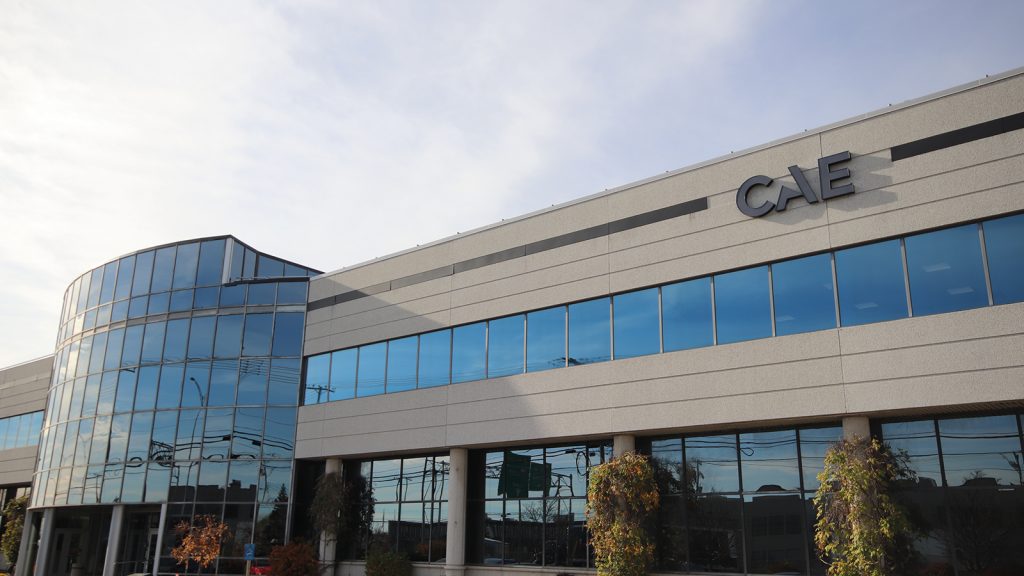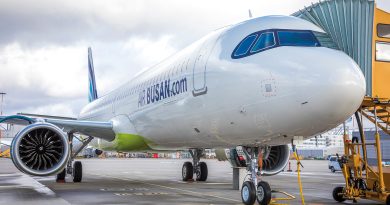CAE Opens First-Ever Air Traffic Services Training Centre
CAE is known for building world-class flight trainers. But on January 16, 2025, the company changed its game by officially opening up CAE’s first-ever Air Traffic Services Training Centre (ATSTC) on its campus in Montreal, Canada. This ATSTC has been created in association with NAV CANADA, Canada’s privately-owned air navigation service provider (ANSP) that staffs civilian air traffic control towers nationwide.
Moving into a new aviation market is a major step for CAE and the company knows it. This is why the January 16th opening was such an uncharacteristically public, even splashy, event for CAE, which historically has kept a low profile in such circumstances. Launching the ATSTC is such a major milestone for the company, in fact, that CAE invited aviation journalists from around the world for a three-day press event on site that culminated in the official opening.
In turn, the opening itself attracted so much media attention with television cameras everywhere, that one might think they had stumbled into a Hollywood premiere by mistake.
Aerospace Innovations magazine was one of the select few who were invited to cover the CAE ATSTC media event in full, which included tours of the company’s Montreal factory and numerous interviews. The innovations we saw in those tours — which included interactive augmented reality simulators operating smoothly on Apple Vision Pro goggles and in-the-lab conversions of single engine gasoline aircraft to electric propulsion — will be covered in an upcoming edition of this magazine. In this story, we will tell you all about CAE’s groundbreaking entry into the air traffic control training market.
An Ongoing Shortage of Air Traffic Controllers
There’s a very simple reason why CAE is entering the air traffic control training market: The current framework for producing air traffic controllers just isn’t keeping up with demand.
As a result, the world has been suffering a chronic shortage of air traffic controllers, even though the pay is relatively good. It’s not just a matter of the Baby Boomers retiring, although that is having an impact. Because air traffic control is such a demanding, stressful and high stakes profession, most people aren’t suited to do the job. Meanwhile, those who are suited take a long time to train.
A recent article on CNN.com entitled, ‘America desperately needs more air traffic controllers. So why is it so tough to hire them?’ puts the shortage’s impact into perspective. “The Federal Aviation Administration, which runs the air traffic system, stepped up the pace of hiring in 2024 under President Joe Biden,” wrote CNN’s Chris Isidore. “But even though 2,000 qualified applicants were hired last year, they might only just barely replace the 1,100 who left the job either through retirement or due to the heavy toll the stressful job takes on those who enter the field. That’s because nearly half of those hired in any given year will wash out of the program before they get to actually control aircraft after about three years from their initial start date. So even with an increase in the pace of hiring, it could take as much as 8 to 9 years to reach full staffing.”
In Canada, the ANSP NAV CANADA has historically been the sole source of air traffic controller training. But they too are having trouble keeping up with demand. This is why, as we will see, NAV CANADA is more than happy to partner with CAE to bolster ATC training capacity in Canada.
This fact also explains why CAE’s ATSTC has actually been operating in ‘soft launch mode’ since October 2024. If all goes to plan, CAE hopes to train approximately 500 air traffic professionals in its ATSTC by 2028. In this system, CAE’s instructors are providing initial training for air traffic controllers (ATC) and flight service specialists (FSS) to students from across Canada using NAV CANADA’s existing training curriculum and courseware. Concurrently, NAV CANADA is continuing to deliver basic training, all specialty courses, and on-the-job training to Canadian ATC/FSS students, with the higher levels of Air Traffic Services training still being solely provided by this ANSP.
The Big Day
Thursday, January 16, 2025 was a relatively typical winter’s day in Montreal. The temperature was below freezing and a light snow was falling. An intermittent wind kept things brisk for anybody walking outside.
At CAE’s ATSTC low-rise building at 8585 De la Côte-de-Liesse Road — which backs onto the southeast end of the city’s Montréal-Pierre Elliott Trudeau International Airport (aka Dorval Airport to the locals) — things were buzzing prior to the official opening. A podium had been set up in front of a bank of monitors at the building’s reception desk, CAE’s white logo splashed across blue screens on the wall. On the other side of the podium, a host of TV cameras battled with invited guests for space on the lobby floor to watch the upcoming event. And reporters being reporters, at least some of them eyed the well-stocked buffet tables to the side of the room that had been set up to celebrate the occasion.
At the appointed time, CAE President and CEO Marc Parent stepped up to the podium after an appropriate introduction, and got the official opening ceremony underway. For the record, Parent has served in this position since 2009, having joined CAE four years previously as Group President, Simulation Products before retaining three promotions to reach the top.
According to www.cae.com, “Mr. Parent has 40 years of experience in the aerospace industry. He started his career in 1984 with Canadair [later Bombardier] as an engineer on the Challenger and Canadair regional jet programs. Beginning in 1993, he held positions of increasing scope in aircraft product development.” These products included the Challenger 604 business jet, the Q400 turboprop, followed by other versions of the Challenger and the CRJ 200 Regional Aircraft product line. Parent’s honours include being appointed as a Member of the Order of Canada (the country’s highest honour) and induction into Canada’s Aviation Hall of Fame, among many others.
This is the acclaimed aerospace executive who has diversified CAE into the ATS training space. Judging by his comments as first speaker during the CAE ATSTC’s official opening ceremony, Marc Parent feels a sense of pride and confidence in doing so.
“Thank you for joining us today on this fantastic day: The inauguration of our new and first-in-world Air Traffic Services Training Centre,” Parent told the packed CAE lobby. “We’re extremely proud to celebrate this groundbreaking milestone, CAE’s entry into the air traffic services training business.” He then said that this expansion was “a natural extension of our core mission at CAE, which is — and we consider it a noble mission — to make the world a safer place. That’s really what we wake up in the morning wanting to do and what fills every single employee in this company with the pride they have in accomplishing that noble mission. And we’ve been doing that for over 75 years.”
According to Marc Parent, taking CAE into the air traffic control sector not only expands the global training ecosystem for this profession, but also ensures that critical roles in aviation are being filled by highly skilled professionals; “again to keep our skies safe,” he said.
Parent then observed that global demand for aviation services continues to grow, noting that “the number of airline passenger traffic jets is going to double over the next 10 years. And what does that mean? That means more pilots are needed, it means more air traffic controllers are needed around the world — and those people haven’t even started training!” he said.
As a result, the timing of CAE’s decision to move into air traffic controller training “couldn’t be more significant,” said Parent. “We’re not just meeting an industry need here, we’re cementing CAE’s position as the trusted leader in aviation workforce development.”
He then made clear how vital this move is to the future health of his company. “This ATS business, for us, isn’t just important for what it achieves today: It’s foundational for CAE’s future growth,” said Parent. “So in conclusion, we are celebrating not just a facility, but a vision: A vision for what CAE can achieve in the future.”
NAV CANADA Equally Enthusiastic
The enthusiasm for the new ATSTC that was expressed by CAE’s Marc Parent was matched by Mark Cooper, President and CEO of NAV CANADA. Apparently his entire company feels the same way. Speaking at the podium after Parent had concluded, Cooper said, “I think it’s a measure of our commitment that literally the entire executive team of NAV Canada wanted to be here today. I don’t think that’s ever happened before.”
For the record: NAV CANADA was established in 1996 when the Canadian government sold off its air traffic control system to the private sector. Funded by fees charged to aircraft operators, NAV CANADA manages 18 million square kilometres of Canadian civil airspace plus the North Atlantic oceanic airspace under Canada’s control.
Continuing his remarks, Mark Cooper reinforced his point about NAV CANADA’s enthusiasm for the CAE ATSTC project by noting how quickly it received approval and support from his company. “Marc [Parent] made a comment about how quickly it went,” said Cooper: “It did. This is unprecedented how quickly we moved from an RFP through a contract signature into execution. There’s a joke that goes around in air traffic that ANSPs, like ourselves, move at the pace of icebergs — and some people say we don’t [even] move that quickly.”
Switching to a more serious tone, Cooper said the collaboration between CAE and NAV CANADA in creating and operating the ATSTC should address “both our current needs and our future needs in air traffic operations. It’s essential for us that we invest in high quality training to maintain and enhance the standards [that] we have. We stand, as Canada, in a really fantastic position at the crossroads of global aviation, and it’s incumbent on us as a company to deliver those standards because we connect the country. We are part of the social fabric, whether the people realize it or not. You don’t get your parcels and you don’t get to travel if we are not delivering a service.”
“That’s why we picked a company like CAE to help us live up to those standards because we can’t fail,” said Cooper. “Things cannot go wrong.” He then cited the importance of the ATSTC graduating close to 500 students by 2028 to help NAV CANADA keep Canadians flying. “That is imperative to us as we look to rebuild our staffing to meet future demands,” he told the audience. With air traffic expected to increase in Canada up to 60% by 2050 — “and that doesn’t include the other versions of transport that we don’t yet see like air mobility” — more air traffic controllers are vitally needed in this country, and soon.
The good news: NAV CANADA has real faith in CAE’s ATSTC providing a real solution to the shortage of air traffic controllers in Canada. “I would happily just close and just say we are filled with optimism,” Cooper said.
The Person in Charge
Every successful enterprise needs someone at the top to make it work. When it comes to CAE’s new ATSTC, that person is Marie-Christine Cloutier. She is CAE’s Vice President – Strategy, Performance & Marketing and Head of the company’s new Air Traffic Services (ATS) division.
Cloutier opened her comments during the opening ceremony by thanking NAV CANADA for their support in this enterprise. She then noted that, “As Mark [Cooper] previously mentioned as well, to meet the high demand in air traffic service personnel, CAE will increase NAV CANADA’s training capacity by training close to 500 additional students by 2028. Indeed, we are the first approved training organization for air traffic services in Canada. Having successfully navigated through audits from both NAV CANADA and Transport Canada [the federal department that regulates Canadian airspace], I think we can acknowledge that it’s quite an achievement.”
Speaking as the person responsible for CAE’s ATSTC, Marie-Christine Cloutier outlined her top two priorities at this point in time, through the training that will be provided by 36 skilled ATS instructors that the company has hired from around the world. Their first priority will be to deliver the high standard of training already being provided by NAV Canada, said Cloutier. Second, and not surprising given CAE’s existing global reach, this ATSTC will seek to serve ANSPs outside of Canada who are also grappling with ATS/FSS staffing shortages. Finding potential ATS/FSS candidates and “training them to meet all the safety standards fast enough to help ANSPs worldwide is going to be our next challenge, like we’ve done with NAV CANADA,” she said.
Moving into Defence?
At present, CAE’s ATSTC is focused on training ATC/FFS personnel for civilian aviation. However, the company also foresees business opportunities in the defence space. “There’s definitely potential there, and we do have many defence and security training facilities that we want to leverage as part of it,” said Cloutier, speaking to reporters after the opening ceremony had concluded. “I mean, we have partnerships between defence companies and ANSPs with our defence and security business segments. So yes, there’s definitely something that we want to explore, plus this could be a point of entry into different countries.”
Reflecting more generally on CAE’s move into air traffic control training, Marie-Christine Cloutier explained it as a response to the company’s ongoing ‘aviation talent forecast’ which it compiles every two years. “The last one that we issued, talked about 1.3 million aviation professionals being needed for the aerospace world, from pilots to cabin crew to maintenance technicians,” she said. “A lot of the comments that we received in response to that forecast was: ‘well, there’s also a shortage in air traffic controllers and flight service specialists. Aren’t you addressing that?’”
This feedback, plus NAV CANADA’s desire to find outside help to boost its ATC/FSS training output, is what inspired CAE to move into this training market. As this move is an addition to the company’s traditional flight training business, “it’s not a transformation, but an extension of what we do,” said Cloutier, “leveraging our existing training capabilities and pilot training and cabin crew training to air traffic controller training.”
A Transformative Force?
It is early days for CAE’s move into air traffic control training. And given that the company is starting in the Canadian market first, it may be premature to suggest this, but this could be the beginning of a new global presence in this aviation sector.
Or not: When CAE was established in 1947 as Canadian Aviation Electronics Ltd. by ex-RCAF pilot Ken Patrick, it started by serving Canada first. And the company didn’t get into simulators until the 1960s, when the Canadian government gave it a contract for six F-104 Starfighter simulators. The success of that contract led to CAE building 26 more simulators for five other NATO countries, and the rest as they say, is history.
Today, even though CAE maintains its headquarters and manufacturing facility in Montreal, the company now has approximately 13,000 employees in more than 240 sites and training locations in over 40 countries worldwide.
So can CAE use its first ATSTC as a launching pad for global air traffic control training facilities? History suggests that it can.
By James Careless




